Porous Materials
Phase Composition Curves in Freezing Porous Materials
The relationship between unfrozen water content and temperature in frozen soils has been repeatedly confirmed since its first observation in the early 20th century. In geotechnical engineering, this relationship was extensively studied in terms of the Phase Composition Curves (PCC) in 1960s. A typical outcome was the considerable number of data published in the First International Permafrost Conference in 1966. This relationship has been recognized as a fundamental relationship in cold regions engineering due to its essential role as a constitutive relationship between two fundamental quantities in frozen soils, i.e., unfrozen water content and temperature.
Despite its long research history and essential role, the PCC has not been studied and applied as extensively as the SWCC in unsaturated soils. One possible reason is that a physical understanding of this relationship had long been absent until recently. As a result, empirical equations were usually used to formulate the PCC. These equations have difficulties in guaranteeing satisfactory predictions due to their empirical nature. This situation made the nature of the PCC unrevealed and the relevant research seriously lag behind.
In a recent study, Liu and Yu (2013, 2014) succeeded in presenting a physical description for the PCC in frozen soils and, for the first time, obtaining a closed-form physically-based equation for this relationship. The proposed prediction equation was proven to be able to yield excellent fitting results for both PCCs measured by the authors (Fig. 1a) and published data for a variety of soils (Fig. 1b), in a large temperature range (Fig. 1c), and in both freezing and thawing processes (Fig. 1d). Since soils are a typical example of the ubiquitous porous materials, it is logical and also significant to ask whether the PCC is a common characteristic of all porous materials. This study is proposed to answer the question.

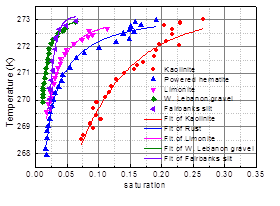
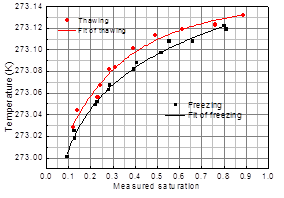

Wettability of Soils
Despite the development of the Lucas-Washburn equation since 1920s (Lucas, 1918; Washburn, 1921), the CRM for porous materials based on this equation had not been extensively investigated until 1990s (Adamson, 1990). Due to this reason, there are only a few attempts at applying this type of method to soils. The earliest effort was the study of Letey et al. (1962) on the measurement of liquid-solid contact angles in soils based on both Poiseuille's approximation and the force balance for infiltration into soil, which were equivalent to the Lucas-Washburn equation. Siebold et al. (1997) applied the CRM to silica flour and calcium carbonate by measuring both the height (by a scale) and mass (by Kruss 12 tensiometer) of imbibed liquids. Michel et al. (2001) measured the wettability of partly decomposed peats with a Kruss 12 tensiometer based on the CRM, in which the tortuosity of the capillaries was considered. Abu-Zreig et al. (2003) made a simple application of the CRM for measuring the contact angles between soils and various test liquids while studying the effect of surfactants on hydraulic properties of soils. Geobel et al. (2004) claimed their study to be the first one that applied the CRM to soil aggregates. In this study, the masses of imbibed liquids were measured with an electronic balance; and details in experiment setup and influencing factors were discussed. Ramirez-Flores et al. (2008) followed Goebel's method (Geobel et al., 2004) for measuring the contact angles of intact soil aggregates, packings of intact aggregates, and packings of crushed aggregates of 9 topsoils and 3 humus subsoils.
A recent publication of the authors (Liu et al., 2013) reported that the contact angle may play a significant role in unsaturated soils via the soil water characteristic curve. And a modified way for implementing CRM was briefly introduced but not detailed. This study presents a comprehensive study for applying the CRM to the contact angle measurement of hydrophilic soils. The deviations of analytical solutions to various forms of the Lucas-Washburn equation were presented to offer a detailed study on the theoretical basis for applying the CRM to soils, which is absent in existing studies. Measures were taken to overcome several difficulties preventing accurate contact angle measurements with the CRM: 1) a self-fabricated tube with special design to eliminate external meniscus; 2) specially designed soil specimen preparation procedures to ensure consistency in sample qualities and repeatability of experiments; 3) automatic data processing to avoid subjective factors. A comparative study is conducted to evaluate several different ways for implementing the CRM, which includes the one used by most of the existing studies. A modified CRM method is suggested and validated based on the comparative study. Contact angles were measured for the specimens made of two typical soils, either sieved or unsieved. This pioneering study will provide a complete and detailed reference for later investigations into the contact angle of soils, especially those using the CRM, which are expected to be boomed as the significant role of the contact angle is more and more clearly realized.
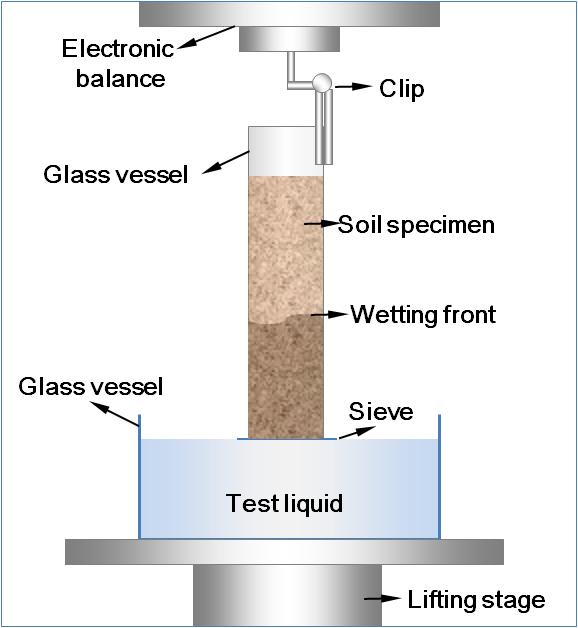
Contact angles much greater than zero were observed for all of the tested soil specimens which contradicts the assumption of perfect wettability in current SWCC studies. In addition, it was demonstrated that neglecting the variations of contact angles with respect to factors such as pore radius could result in significant errors during the SWCC construction. It is anticipated that the SWCC research will be further advanced by taking into account the influence of contact angle (see the following figure).
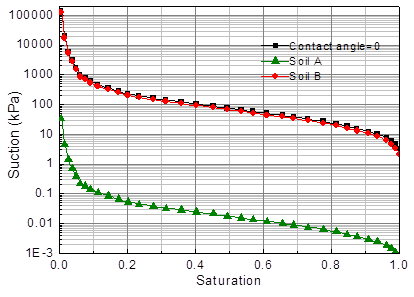
Measurement of Water Characteristic Curves
The soil water characteristic curve (SWCC) is the basis to explain a variety of processes in unsaturated soils, ranging from transport phenomena to mechanical behaviors. In this paper, a new method is developed for SWCC estimation based on the similarity between the freezing/thawing process and drying/wetting process in soils. The theoretical basis for this method is first reviewed. The concept of Soil Freezing Characteristic Curve (SFCC) is introduced to describe the relationship between the unfrozen water content and matric suction in frozen soils. SFCC is analogous to SWCC in that both of them describe the energy status of liquid water associated with liquid water content. Relationships between SWCC and SFCC are discussed. To measure the SFCC, a thermo-TDR (time domain reflectometry) sensor was developed which combines both temperature sensors and conventional TDR sensor. The TDR module and algorithm measured the bulk free water content of soils during the freezing/thawing processes, while the built-in thermocouples measured the internal temperature distribution. SFCC were obtained from the simultaneously measured TDR and temperature data. Experiments were conducted on a few types of soils to validate this new procedure. The SFCC is obtained from thermo-TDR data collected in specimens subjected to a controlled thawing process, while the SWCC was directly measured by ASTM D5298 the filter paper method. Reasonable agreements were found between SWCC and SFCC. The experimental results implied that the SWCC could be estimated from SFCC, which also provided another evidence on the similarity of freezing/thawing processes and desorption/sorption processes.
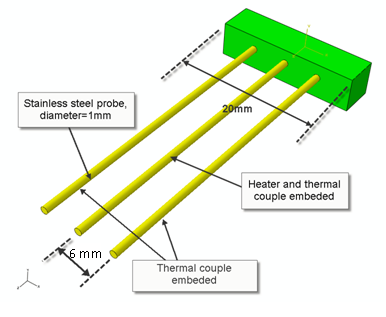
Ultrasonics for Pore Size Distribution in Concrete
The air void size distribution is critical for many concrete properties such as strength, freeze-thaw susceptibility, and thermal and transport properties. Measuring the characteristics of air voids in concrete (especially in early-stage) is thus important to assessing its long-term durability. This research aims to develop nondestructive ultrasonic technique will be developed for potential concrete mixture quality control both in lab and field applications. LiuRG has been collaborated with Dr. Sarah Sun from MEEM at Michigan Tech, Dr. Babara Dai at CEE at Michigan Tech and Dr. Bill Yu from CE at Case Western Reserve University on this research.

